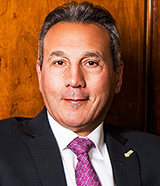Xi Jinping made a few calculated stops on his way to the 10th Brics leaders’ summit in South Africa this July. The trip – his first since he was reappointed as president of the People’s Republic of China in March – took him to the UAE, Senegal and Rwanda, with a final stop in Mauritius once the summit ended.
When Xi touched down in Dakar, he was given a hero’s welcome. A brass band played while Senegalese and Chinese flags waved high in the air. A couple of deals were signed during Xi’s whistle-stop trip, and what did become clear is that Senegal, a country that lies on the Atlantic Coast far beyond the original reach of the Belt and Road Initiative (BRI), is now firmly part of it.
“In the Middle East and Africa, Chinese involvement is becoming much broader, much more diversified,” says Carmen Ling, global head of renminbi internationalization and Belt and Road at Standard Chartered. Today, China’s interest in the region has few limits.
Over the last year, BRI has become something much more tangible in the Middle East and Africa. In east Africa, the modern railway systems connecting Addis Ababa to Djibouti and Nairobi to Mombasa funded by the Export-Import Bank of China are up and running. China has also started the development of a cross-country railway line that will connect Zambia to Malawi.
In the UAE, China’s largest shipping company, Cosco, is building new terminals in Abu Dhabi to support trade. In Oman, China has invested $10.7 billion to develop an industrial city in the small port town of Duqm, while it is the largest investor in the development of Egypt’s Suez Canal corridor.
In the Middle East, China has pumped money into oil refineries and renewable energy, in part to satiate its own energy needs. In 2017, China imported $162.2 billion-worth of crude oil, 44% of it from the Middle East.
“Chinese interest in the region is no longer characterized by oil exploration and infrastructure development,” says Alexious Lee, head of China capital access at CLSA.
“In the Middle East, for example, we see growing appetite in real estate, hospitals and pharmaceuticals – sectors which are benefitting from increased connectivity and prosperity in the region. And this is all gathering pace because China builds things quickly,” he adds.
Ling from Standard Chartered says: “Reliable infrastructure development in Africa has a longer-term impact on the economy; it facilitates commercial activity and creates jobs for people.
“This activity is spreading to countries in Africa that you might not necessarily associate with BRI. Our Chinese clients are looking at business opportunities in places such as Ghana, Nigeria and Gambia under the BRI remit.”
The Middle East and Africa has become a testing ground for the internationalization of the renminbi, and cross-border trade and investment continue to increase. According to research from HSBC, the use of the renminbi in cross-border trade grew from 4% in 2016 to 16% in 2017 in the Middle East and North Africa.
Nigeria and China signed a bilateral swap agreement in April, which will hopefully bring down the cost of trade between the two countries. The Macroeconomic and Financial Management Institute of Eastern and Southern Africa (MEFMI) held a forum in May, where 14 African countries discussed the future use of the renminbi to support sovereign reserve management.
|
Mohamed Mahmoud |
“The use of the renminbi will streamline trade and help Africa and the Middle East diversify reserves,” says Mohamed Mahmoud Ahmed El-Etreby, chairman of Egyptian lender Banque Misr.
As China’s economic and political influence seeps beyond the original Silk Road, some analysts argue that BRI is just a buzzword, an excuse for China to get involved in anything and everything in the Middle East and Africa, but more importantly a way in which China can spread its political influence in the region. In August 2017, China officially opened a military base in Djibouti.
Others say that more countries and sectors will naturally want to come under the initiative as BRI develops and grows, and that the consequences of Chinese investment and bilateral trade in the region is mutually beneficial.
“BRI has stimulated growth, increased trade, created jobs and will help to alleviate poverty through better market access,” says Altay Atli, an economist based in Istanbul.
Chinese investment in Africa generated 38,417 jobs in 2016, according to research by EY, which was more than three times the number of jobs created by the next biggest investor in the continent, the US.
“BRI benefits everyone, not just China,” says Atli.
As Clarence Singam-Zhou, chief executive of First Abu Dhabi Bank in Asia, points out: “China’s focus on the region has naturally resulted in stronger economic relations and closer strategic ties to the Middle East and Africa. And as the BRI initiative takes shape, countries in the Middle East and Africa will partner with China to drive greater economic diversification through privatization, public-private partnerships and the transfer of technology. The relationship is evolving.”
Ling adds: “Infrastructure projects are necessary building blocks, but what they really do is to spur other economic and commercial activities that will see greater participation from the private sector.”
China’s intentions in Africa and the Middle East are far reaching and complex. But as long as the relationship remains mutually beneficial and supports the wider development goals of the region, Chinese trade and investment will be welcome. In future, roads alone just won’t cut it.


 Signal2forex.com - Best Forex robots and signals
Signal2forex.com - Best Forex robots and signals




